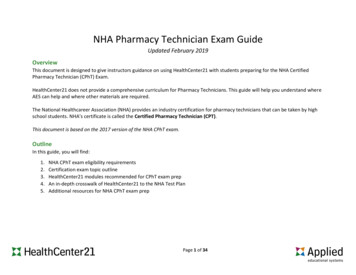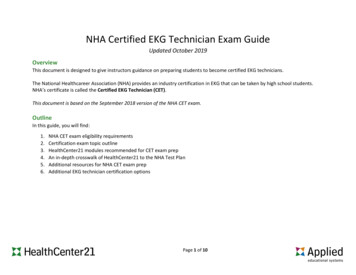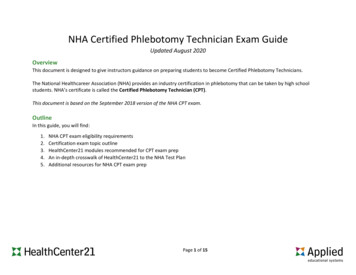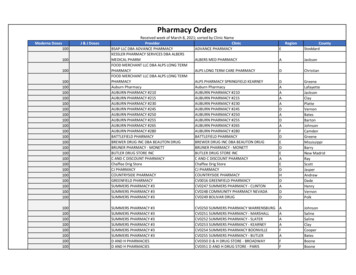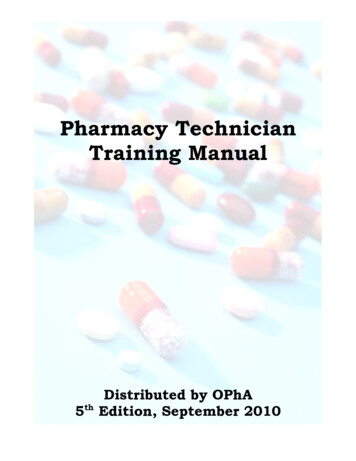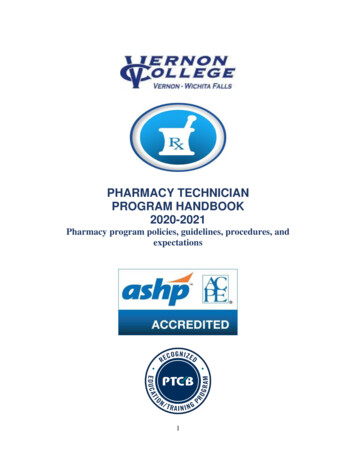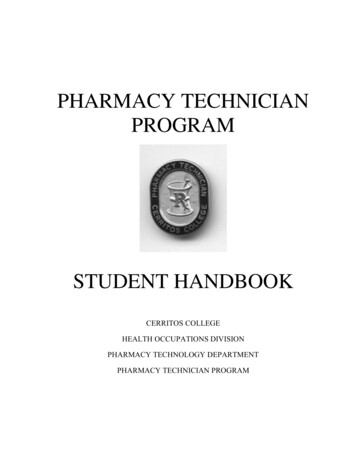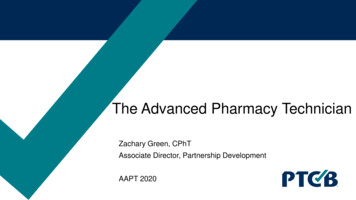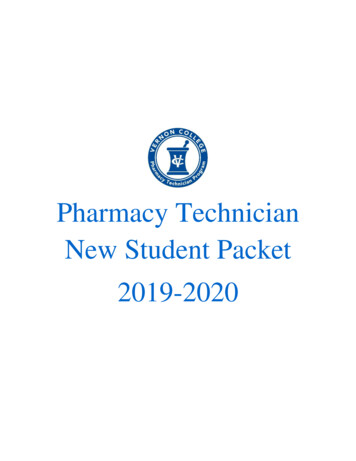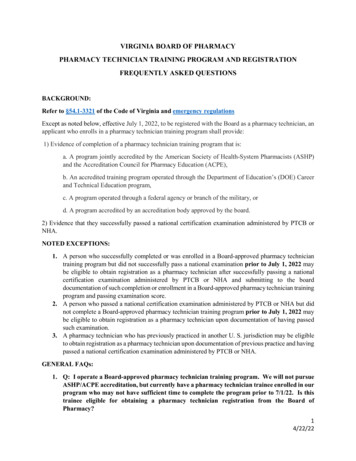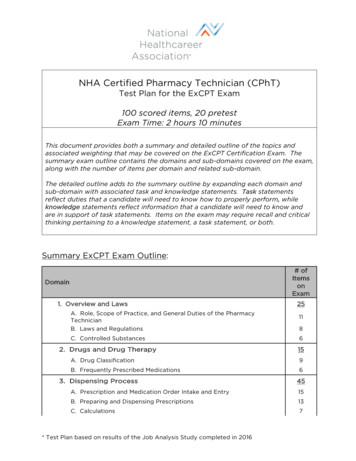
Transcription
NHA Certified Pharmacy Technician (CPhT)Test Plan for the ExCPT Exam100 scored items, 20 pretestExam Time: 2 hours 10 minutesThis document provides both a summary and detailed outline of the topics andassociated weighting that may be covered on the ExCPT Certification Exam. Thesummary exam outline contains the domains and sub-domains covered on the exam,along with the number of items per domain and related sub-domain.The detailed outline adds to the summary outline by expanding each domain andsub-domain with associated task and knowledge statements. Task statementsreflect duties that a candidate will need to know how to properly perform, whileknowledge statements reflect information that a candidate will need to know andare in support of task statements. Items on the exam may require recall and criticalthinking pertaining to a knowledge statement, a task statement, or both.Summary ExCPT Exam Outline:# ofItemsonExamDomain1. Overview and LawsA. Role, Scope of Practice, and General Duties of the PharmacyTechnicianB. Laws and Regulations25118C. Controlled Substances62. Drugs and Drug Therapy15A. Drug Classification9B. Frequently Prescribed Medications63. Dispensing Process45A. Prescription and Medication Order Intake and Entry15B. Preparing and Dispensing Prescriptions13C. Calculations7* Test Plan based on results of the Job Analysis Study completed in 2016
D. Sterile and Nonsterile Products, Compounding, Unit Dose, andRepackaging4. Medication Safety and Quality AssuranceTotal1015100Detail ExCPT Exam Outline:Domain 1: Overview and LawsA.Role, Scope of Practice, and General Duties of the Pharmacy Technician1. Differentiate between tasks that may be performed by a pharmacytechnician and those that must be performed by a pharmacist.Supporting Knowledge:a. Role of the pharmacy technicianb. Role of the pharmacist (for example: verification of prescriptions,requirements for counseling)c. Scope of pharmacy technician practiced. Pharmacy operations and process flowe. Pharmacy practice settings (for example: community, institutional,in-patient, long-term care, compounding)2. Maintain pharmacy security (for example: secure medications, preventunauthorized access).Supporting Knowledgea. Pharmacy security measures (for example: sign off, barriers)b. Authorized personnel (including law enforcement), access topharmacy areas, identification requirements, level of supervision3. Assist pharmacist in medication reconciliation.Supporting Knowledgea. Purpose and benefits of medication reconciliation and pharmacytechnician's role in medication reconciliationb. Medical terminology (for example, pharmacy abbreviations,prefixes, suffixes, root words, combining vowels)c. Communication methods and strategies (for example, interviewingtechniques, non-verbal cues, communication styles)4. Assist pharmacist in medication therapy management.Supporting Knowledgea. Purpose and benefits of medication therapy management (MTM)and pharmacy technician's role in MTMb. Medical terminology (for example: pharmacy abbreviations,prefixes, suffixes, root words, combining vowels)c. Communication methods and strategies (for example: interviewingtechniques, nonverbal cues, communication styles)5. Assist patient in selecting compliance aids and devices.Supporting Knowledge* Test Plan based on results of the Job Analysis Study completed in 2016‘ ’ Indicates content areas that might require calculations2511
a. Benefits of compliance aids and devices (for example: lockboxes,timers, personalized automatic dispensing devices)b. Communication methods and strategies (for example: interviewingtechniques, nonverbal cues, communication styles)6. Interpret basic medical terminology commonly used in the pharmacy.Supporting Knowledgea. Medical terminology (for example: pharmacy abbreviations,prefixes, suffixes, root words, combining vowels)7. Tailor communications to different audiences, including patients,caregivers, staff, and health care professionals.Supporting Knowledgea. Communication methods and strategies (for example: interviewingtechniques, nonverbal cues, communication styles)8. Interact with customers and patients in a professional manner, includinginternal and external customers.Supporting Knowledgea. Communication methods and strategies (for example: interviewingtechniques, nonverbal cues, communication styles)9. Confirm final product verification has been completed by pharmacistprior to release to patient.Supporting Knowledgea. Role of the pharmacy technicianb. Role of the pharmacist (for example: verification of prescriptions,requirements for counseling)10. Assist the pharmacist in managing inventory by placing, receiving,verifying, rotating, and stocking orders. Supporting Knowledgea. Pharmacy operations and process flowb. Components of drug pricingc. Ordering and inventory management methods (for example: PARlevels, just in time ordering, rotating inventory, fast movers)11. Store medications following manufacturers’ requirements (for example:light, temperature, humidity).Supporting Knowledgea. Pharmacy operations and process flowb. Storage requirements for medications12.Identify and remove expired products in a pharmacy’s inventory. Supporting Knowledgea. Pharmacy operations and process flowb. Ordering and inventory management methods (for example: PARlevels, just in time ordering, rotating inventory, fast movers)* Test Plan based on results of the Job Analysis Study completed in 2016‘ ’ Indicates content areas that might require calculations
13. Identify and remove recalled products from inventory. Supporting Knowledgea. Pharmacy operations and process flowb. Classes of recalls and required actionsc. Ordering and inventory management methods (for example: PARlevels, just in time ordering, rotating inventory, fast movers)d. Disposal methods14. Dispose of medications based on product-specific requirements.Supporting Knowledgea. Pharmacy operations and process flowb. Disposal methodsc. Material Safety Data Sheets (MSDS)/Safety Data Sheets (SDS)15. Access and use references and resources as needed to perform jobduties.Supporting Knowledgea. USP Standardsb. Orange Bookc. Red Bookd. Clinical information sources (for example: Drug Facts andComparisons, Micromedex, Lexicomp, Up to Date)e. Ident-a-drugf. Handbook on Injectablesg. State Board of Pharmacy regulationsh. Poison Control CentersB.Laws and Regulations1. Comply with federal laws and regulations applicable to pharmacy practice.Supporting Knowledgea. Health Insurance Portability and Accountability Act (HIPAA)b. Combat Methamphetamine Epidemic Act of 2005 (CMEA)c. Drug Listing Act of 1972 (including elements of the NDC)d. Food and Drug Act of 1906e. Omnibus Budget Reconciliation Act of 1990 (OBRA 90)f. Durham-Humphrey Amendmentg. Food, Drug, and Cosmetic Acth. Drug Supply Chain Security Act (DSCSA) a.k.a. Track and Trace* Test Plan based on results of the Job Analysis Study completed in 2016‘ ’ Indicates content areas that might require calculations8
i. Laws related to bioequivalencej. Poison Prevention Packaging Act (PPPA)k. Kefauver-Harris Amendmentl. Orphan Drug Actm. Medicare Modernization Actn. Centers for Medicare and Medicaid Services (CMS)o. Anabolic Steroid Actp. Safe handling and disposal practices for hazardous drugs (USP 800 )q. Laws related to non-controlled substances when handling refillsand/or partial filling of prescriptions2. Maintain HIPAA compliance while communicating and disclosinginformation with patients, caregivers, health care professionals, and others.Supporting Knowledgea. Health Insurance Portability and Accountability Act (HIPAA)3. Comply with HIPAA requirements regarding collection, storage, anddisposal of patientinformation.Supporting Knowledgea. Health Insurance Portability and Accountability Act (HIPAA)4. When filling prescriptions or medication orders, comply with applicablelaws and regulations.Supporting Knowledgea. Health Insurance Portability and Accountability Act (HIPAA)b. Combat Methamphetamine Epidemic Act of 2005 (CMEA)c. Drug Listing Act of 1972 (including elements of the NDC)d. Food and Drug Act of 1906e. Omnibus Budget Reconciliation Act of 1990 (OBRA 90)f. Durham-Humphrey Amendmentg. Food, Drug, and Cosmetic Acth. Laws related to bioequivalencei. Poison Prevention Packaging Act (PPPA)j. Medicare Modernization Actk. Centers for Medicare and Medicaid Services (CMS)l. Anabolic Steroid Actm. Safe handling and disposal practices for hazardous drugs (USP 800 )n. Laws related to non-controlled substances when handling refillsand/or partial filling of prescriptionso. Organizations/regulators related to pharmacy practice (forexample: OSHA, The Joint Commission, FDA)5. Follow laws and regulations for non-controlled substances when handlingrefills and/or partial filling of prescriptions.Supporting Knowledgea. Health Insurance Portability and Accountability Act (HIPAA)* Test Plan based on results of the Job Analysis Study completed in 2016‘ ’ Indicates content areas that might require calculations
b. Combat Methamphetamine Epidemic Act of 2005 (CMEA)c. Drug Listing Act of 1972 (including elements of the NDC)d. Food and Drug Act of 1906e. Omnibus Budget Reconciliation Act of 1990 (OBRA 90)f. Durham-Humphrey Amendmentg. Food, Drug, and Cosmetic Acth. Laws related to bioequivalencei. Poison Prevention Packaging Act (PPPA)j. Medicare Modernization Actk. Centers for Medicare and Medicaid Services (CMS)l. Anabolic Steroid Actm. Safe handling and disposal practices for hazardous drugs (USP 800 )n. Laws related to non-controlled substances when handling refillsand/or partial filling of prescriptionso. Organizations/regulators related to pharmacy practice (forexample: OSHA, The Joint Commission, FDA)6. Package prescription medications in child-resistant containers or otherapproved containers as required.Supporting Knowledgea. Food, Drug, and Cosmetic Actb. Poison Prevention Packaging Act (PPPA)7. Comply with OSHA regulations for disposal of sharps.Supporting Knowledgea. Organizations/regulators related to pharmacy practice (forexample: OSHA, The Joint Commission, FDA)8. Comply with laws related to monitoring and reporting fraud, waste, andabuse.Supporting Knowledgea. Combat Methamphetamine Epidemic Act of 2005 (CMEA)b. Drug Supply Chain Security Act (DSCSA) a.k.a. Track and Tracec. Medicare Modernization Actd. Centers for Medicare and Medicaid Services (CMS)e. Anabolic Steroid Actf. Organizations/regulators related to pharmacy practice (for example:OSHA, The Joint Commission, FDA)9. Follow record-keeping and retention procedures per federalrequirements.Supporting Knowledgea. Health Insurance Portability and Accountability Act (HIPAA)b. Combat Methamphetamine Epidemic Act of 2005 (CMEA)c. Drug Listing Act of 1972 (including elements of the NDC)d. Food and Drug Act of 1906e. Omnibus Budget Reconciliation Act of 1990 (OBRA 90)* Test Plan based on results of the Job Analysis Study completed in 2016‘ ’ Indicates content areas that might require calculations
f. Durham-Humphrey Amendmentg. Food, Drug, and Cosmetic Acth. Drug Supply Chain Security Act (DSCSA) a.k.a. Track and Tracei. Laws related to bioequivalencej. Poison Prevention Packaging Act (PPPA)k. Kefauver-Harris Amendmentl. Orphan Drug Actm. Medicare Modernization Actn Centers for Medicare and Medicaid Services (CMS)o. Anabolic Steroid Actp. Safe handling and disposal practices for hazardous drugs (USP 800 )q. Laws related to non-controlled substances when handling refillsand/or partial filling of prescriptionsr. Organizations/regulators related to pharmacy practice (for example:OSHA, The Joint Commission, FDA)C.Controlled Substances1. Differentiate among the controlled substances schedules and the drugswithin them. Supporting Knowledgea. Controlled Substances Act (CSA)b. Drug Enforcement Administration (DEA) for controlled substancesc. Schedules of controlled substances and drugs within themd. Exempt narcoticse. Prescription requirements for controlled substancesf. Elements of and formula for DEA numberg. DEA forms (for example: 41, 106, 222)h. Procedures for ordering, receiving, storing, and disposing ofcontrolled substances2. Identify elements needed to verify the validity of DEA number. Supporting Knowledgea. Elements of and formula for DEA number3. Verify, on intake, required information is on prescription for controlledsubstance. Supporting Knowledgea. Controlled Substances Act (CSA)b. Schedules of controlled substances and drugs within themc. Prescription requirements for controlled substancesd. Elements of and formula for DEA numbere. Expiration dates and refills for controlled substancesf. Laws, regulations, and processes to transfer controlled substancesbetween pharmaciesg. Laws, regulations, and processes to transfer prescriptions forcontrolled substances between pharmacies* Test Plan based on results of the Job Analysis Study completed in 2016‘ ’ Indicates content areas that might require calculations6
h. Diversion and prescription monitoring programs4. Comply with laws and regulations when filling, partial filling, and refillingprescriptions for controlled substances. Supporting Knowledgea. Controlled Substances Act (CSA)b. Schedules of controlled substances and drugs within themc. Prescription requirements for controlled substancesd. Elements of and formula for DEA numbere. Expiration dates and refills for controlled substancesf. Emergency filling proceduresg. Laws, regulations, and processes to transfer controlled substancesbetween pharmaciesh. Laws, regulations, and processes to transfer prescriptions forcontrolled substances between pharmaciesi. Tracking requirements for perpetual inventory of controlledsubstancesj. Diversion and prescription monitoring programs5. File all classes of prescriptions appropriately.Supporting Knowledgea. Controlled Substances Act (CSA)b. Drug Enforcement Administration (DEA) for controlled substancesc. Filing requirements6. Comply with federal laws pertaining to the handling of Schedule V(exempt narcotics) and regulated (BTC) non-prescription products.Supporting Knowledgea. Controlled Substances Act (CSA)b. Drug Enforcement Administration (DEA) for controlled substancesc. Schedules of controlled substances and drugs within themd. Exempt narcoticse. Filing requirementsf. Laws, regulations, and processes to transfer controlled substancesbetween pharmaciesg. Laws, regulations, and processes to transfer prescriptions forcontrolled substances between pharmaciesh. Procedures for ordering, receiving, storing, and disposing ofcontrolled substancesi. Tracking requirements for perpetual inventory of controlledsubstancesj. Diversion and prescription monitoring programs7. Order, store, and maintain inventory of controlled substances inaccordance with CSA.Supporting Knowledgea. Controlled Substances Act (CSA)b. Drug Enforcement Administration (DEA) for controlled substances* Test Plan based on results of the Job Analysis Study completed in 2016‘ ’ Indicates content areas that might require calculations
c. DEA forms (for example: 41, 106, 222)d. Procedures for ordering, receiving, storing, and disposing ofcontrolled substancese. Tracking requirements for perpetual inventory of controlledsubstancesf. Diversion and prescription monitoring programsDomain 2: Drugs and Drug TherapyA. Drug Classification1.159Differentiate among therapeutic classes of drugs.Supporting Knowledgea. Drug classes (for example: analgesics, dermatologics)b. Drug class abbreviations (for example: NSAID, SSRI, ARB, ACE)2. Differentiate among various dosage forms.Supporting Knowledgea. Dosage forms (for example: tablets, capsules, ointments, creams,controlled-release, immediate-release, elixir, suspension)3. Differentiate among various routes of administration.Supporting Knowledgea. Routes of administration (for example: topical, parenteral, oral)4. Match common prescription/legend medications with their indications.Supporting Knowledgea. Indications for frequently prescribed medicationsb. Basic body systems and disease statesc. Prescription/legend medications and their indications5. Match common over-the-counter (OTC) products with their indications.Supporting Knowledgea. Basic body systems and disease statesb. Over-the-counter (OTC) medications and their indications6. Match common behind-the-counter (BTC) products with their indications.Supporting Knowledgea. Basic body systems and disease statesb. Behind-the-counter (BTC) medications and their indicationsB. Frequently Prescribed Medications1. Match brand and generic names of commonly used prescriptionmedications.Supporting Knowledge* Test Plan based on results of the Job Analysis Study completed in 2016‘ ’ Indicates content areas that might require calculations6
a. Drug Topics Top 200 medications (by prescription volume peryear)b. Brand and generic medication namesc. Therapeutic equivalence2. Differentiate between side effects and adverse drug reactions.Supporting Knowledgea. Effects and side-effects of pharmacotherapy3. Differentiate between contraindications and drug interactions.Supporting Knowledgea. Drug interactions (for example: drug-drug, drug-food, drug-OTC)4. Recognize physical interactions and incompatibilities in the preparation ofcompounded and parenteral medications.Supporting Knowledgea. Physical interactions and incompatibilities5. Recognize common vaccines and immunization schedules.Supporting Knowledgea. Vaccine and immunization schedulesDomain 3: Dispensing ProcessA. Prescription and Medication Order Intake and Entry1. Analyze a prescription or medication order for completeness and obtainmissing information.Supporting Knowledgea. Required components of a prescriptionb. Types/formats of prescription/medication orders (for example:telephone, facsimile, electronic prescription orders, computerizedphysician order entry)c. Providers with prescribing authority (what types of providers canprescribe what types of medications)d. Allowable refills based on prescription drug type and drug classe. National Provider Identifier (NPI)f. Purpose and use of SIG codes/pharmacy abbreviationsg. Institute for Safe Medication Practices error-prone abbreviations listh. DAW codes and their uses2. Process prescription orders (for example: telephone, facsimile, andelectronic).Supporting Knowledgea. Required components of a prescriptionb. Types/formats of prescription/medication orders (for example:telephone, facsimile, electronic prescription orders, computerizedphysician order entry)c. Providers with prescribing authority (what types of providers canprescribe what types of medications)* Test Plan based on results of the Job Analysis Study completed in 2016‘ ’ Indicates content areas that might require calculations4515
d. Allowable refills based on prescription drug type and drug classe. Components of a patient profilef. National Provider Identifier (NPI)g. Purpose and use of SIG codes/pharmacy abbreviationsh. Institute for Safe Medication Practices error-prone abbreviations listi. DAW codes and their usesj. Appropriate responses to electronic alertsk. Components required to process a third-party claim (for example:BIN, PCN, prescription group code, person code)l. Coordination of benefitsm. Types of formulariesn. Types of third-party rejections (for example: duplicate therapy, highdose, prior authorization, missing diagnosis code)o. Tiered copaysp. Types of coverage (for example: Medicare, Medicaid, workers’compensation, HMO, patient assistance programs)q. Drug utilization reviews/Drug utilization evaluations3. Process prescription refill authorization requests from prescribers.Supporting Knowledgea. Providers with prescribing authority (what types of providers canprescribe what types of medications)b.Allowable refills based on prescription drug type and drug class4. Obtain information for the patient profile from patients, such asdemographics, medication history (including OTCs and herbal supplements),health conditions, concurrent medications, allergies, and third-party payers.Supporting Knowledgea. Components of a patient profileb. Components required to process a third-party claim (for example:BIN, PCN, prescription group code, person code)c. Types of coverage (for example: Medicare, Medicaid, workers’compensation, HMO, patient assistance programs)5. Enter and maintain electronic patient profiles.Supporting Knowledgea. Components of a patient profileb. Components required to process a third-party claim (for example:BIN, PCN, prescription group code, person code)c. Types of coverage (for example: Medicare, Medicaid, workers’compensation, HMO, patient assistance programs)6. Identify and input third-party payer identifier numbers.* Test Plan based on results of the Job Analysis Study completed in 2016‘ ’ Indicates content areas that might require calculations
Supporting Knowledgea. Components required to process a third-party claim (for example:BIN, PCN, prescription group code, person code)b. Coordination of benefitsc. Types of coverage (for example: Medicare, Medicaid, workers’compensation, HMO, patient assistance programs)7. Process third-party prescriptions (for example: coordination of benefits,rejections, copays, prior authorizations).Supporting Knowledgea. DAW codes and their usesb. Appropriate responses to electronic alertsc. Components required to process a third-party claim (for example:BIN, PCN, prescription group code, person code)d. Coordination of benefitse. Types of formulariesf. Types of third-party rejections (for example: duplicate therapy, highdose, prior authorization, missing diagnosis code)g. Tiered copaysh. Types of coverage (for example: Medicare, Medicaid, workers’compensation, HMO, patient assistance programs)8. Communicate with patients, providers, and/or third-party payers aboutprescription coverage.Supporting Knowledgea. Appropriate responses to electronic alertsb. Components required to process a third-party claim (for example:BIN, PCN, prescription group code, person code)c. Coordination of benefitsd. Types of formulariese. Types of third-party rejections (for example: duplicate therapy, highdose, prior authorization, missing diagnosis code)f. Tiered copaysg. Types of coverage (for example: Medicare, Medicaid, workers’compensation, HMO, patient assistance programs)h. Drug utilization reviews/Drug utilization evaluations9. Translate prescriber’s directions for use into accurate and completedirections for the patient.Supporting Knowledgea. Types/formats of prescription/medication orders (for example:telephone, facsimile, electronic prescription orders, computerizedphysician order entry)b. Allowable refills based on prescription drug type and drug classc. Purpose and use of SIG codes/pharmacy abbreviationsd. Institute for Safe Medication Practices error-prone abbreviations list* Test Plan based on results of the Job Analysis Study completed in 2016‘ ’ Indicates content areas that might require calculations
e. DAW codes and their uses10. Interpret abbreviations used on prescriptions or medication orders.Supporting Knowledgea. Purpose and use of SIG codes/pharmacy abbreviationsb. Institute for Safe Medication Practices error-prone abbreviations list11. Enter prescription information into the computer.Supporting Knowledgea. Required components of a prescriptionb. Types/formats of prescription/medication orders (for example:telephone, facsimile, electronic prescription orders, computerizedphysician order entry)c. Providers with prescribing authority (what types of providers canprescribe what types of medications)d. Allowable refills based on prescription drug type and drug classe. National Provider Identifier (NPI)f. Purpose and use of SIG codes/pharmacy abbreviationsg. Institute for Safe Medication Practices error-prone abbreviations listh. DAW codes and their uses12. Use correct DAW codes when entering prescription data into thecomputer.Supporting Knowledgea. DAW codes and their uses13. Respond to electronic alerts (for example: compliance, interaction, thirdparty payers) while processing a prescription.Supporting Knowledgea. Appropriate responses to electronic alertsb. Types of third-party rejections (for example: duplicate therapy, highdose, prior authorization, missing diagnosis code)c. Drug utilization reviews/Drug utilization evaluations14. Process Durable Medical Equipment (DME) prescriptions, includingcoordination of benefits with Medicare Part B or D.Supporting Knowledgea. Coordination of benefitsb. Types of coverage (for example: Medicare, Medicaid, workers’compensation, HMO, patient assistance programs)c. Durable medical equipmentB. Preparing and Dispensing Prescriptions1. Identify medications that require special handling procedures.Supporting Knowledgea. When to keep medication in original packagingb. Purpose of Risk Evaluation Mitigation Strategies (REMS) programc. Considerations for handling hazardous drugs (USP 800 )* Test Plan based on results of the Job Analysis Study completed in 2016‘ ’ Indicates content areas that might require calculations13
2. Stock and use automated dispensing machines.Supporting Knowledgea. Role and benefits of automated dispensing systems in thepharmacy3. Select appropriate medication product based on prescription/legend,OTC, or BTC status; name and strength; NDC number; expiration date; andlot number.Supporting Knowledgea. Components of an NDC numberb. Distinction between prescription/legend, over-the-counter, andbehind-the-counter medicationsc. Federal restrictions on shipping of specific medications and supplies(for example: diabetic testing supplies, controlled substances)d. Components of an OTC label4. Count/measure or pour medication into appropriate container.Supporting Knowledgea. When to keep medication in original packagingb. Considerations for handling hazardous drugs (USP 800 )5. Select appropriate prescription vials, caps, bottles, and other supplies. Supporting Knowledgea. Poison Prevention Packaging Act (PPPA)b. Measurement systems (for example, metric, household, romannumerals, military time)6. Label medication products packaged in approved containers or, whenappropriate, in original packages.Supporting Knowledgea. When to keep medication in original packagingb. Components of a patient prescription labelc. Label placementd. Purpose of auxiliary labelse. Labels appropriate to different types and classes of drugs7. Select and apply appropriate auxiliary labels.Supporting Knowledgea. Purpose of auxiliary labelsb. Labels appropriate to different types and classes of drugs8. Provide printed patient information leaflets and required medicationguides.Supporting Knowledgea. Purpose of Risk Evaluation Mitigation Strategies (REMS) programb. Prescriptions that require federal medication guidesc. Difference between medication guides and product package inserts9. Package and ship medications according to manufacturers’recommendations.* Test Plan based on results of the Job Analysis Study completed in 2016‘ ’ Indicates content areas that might require calculations
Supporting Knowledgea. Federal restrictions on shipping of specific medications and supplies(for example: diabetic testing supplies, controlled substances)10. Select appropriate OTC product based on pharmacist recommendation.Supporting Knowledgea. Distinction between prescription/legend, over-the-counter, andbehind-the-counter medicationsb. Vitamins, minerals, and herbal supplementsc. Components of an OTC label11. Offer pharmacist consultation to patients.Supporting Knowledgea. Omnibus Budget Reconciliation Act of 1990 (OBRA 90)12. Identify prescriptions that have been forged, copied or possibly altered.Supporting Knowledgea. Security features of prescriptionsC. Calculations1. Convert within and between each of the systems of measurement. Supporting Knowledgea. Measurement systems (for example: metric, household, romannumerals, military time)b. Basic algebra2. Calculate the quantities of prescriptions or medication orders to bedispensed. Supporting Knowledgea. Measurement systems (for example: metric, household, Romannumerals, military time)b. Basic algebrac. mEqd. Unitse. Body surface area (BSA)f. Pediatric dosage calculations (for example: Young’s rule, Clark’s rule,Fried’s rule)g. mg/kg/dayh. Ratio strengthi. w/w%, w/v%, v/v%j. Dilution/concentrationk. Intravenous flow rate (for example: mL/hr)l. Alligation3. Calculate the days’ supply for prescriptions. * Test Plan based on results of the Job Analysis Study completed in 2016‘ ’ Indicates content areas that might require calculations7
Supporting Knowledgea. Basic algebra4. Calculate individual and total daily dosages. Supporting Knowledgea. Basic algebrab. mEqc. Unitsd. Body surface area (BSA)e. Pediatric dosage calculations (for example: Young’s rule, Clark’srule, Fried’s rule)f. mg/kg/dayg. Intravenous flow rate (for example: mL/hr)5. Perform sterile and nonsterile compounding calculations. Supporting Knowledgea. Measurement systems (for example: metric, household, Romannumerals, military time)b. Basic algebrac. Ratio strengthd. w/w%, w/v%, v/v%e. Dilution/concentrationf. Intravenous flow rate (for example: mL/hr)g. Alligation6. Perform basic pharmacy business calculations (for example: pricing andinventory control). Supporting Knowledgea. Basic algebrab. Types of business calculations (for example: markup, percentagemarkup, profit, gross and net profit, cost, overhead, turnover rate)7. Perform temperature conversions. Supporting Knowledgea. Basic algebrab. Temperature scales8. Calculate percentages. Supporting Knowledgea. Basic algebrab. Ratio strengthc. w/w%, w/v%, v/v%d. Dilution/concentration* Test Plan based on results of the Job Analysis Study completed in 2016‘ ’ Indicates content areas that might require calculations
D. Sterile and Nonsterile Products, Compounding, Unit Dose, andRepackaging1. Use Universal Precautions.Supporting Knowledgea. CDC/OSHA Universal Precautions Guidelines2. Employ infection cont
A. Role, Scope of Practice, and General Duties of the Pharmacy Technician 11 1. Differentiate between tasks that may be performed by a pharmacy technician and those that must be performed by a pharmacist. Supporting Knowledge: a. Role of the pharmacy technician b. Role of the pharmacist (for example: verification of prescriptions,
